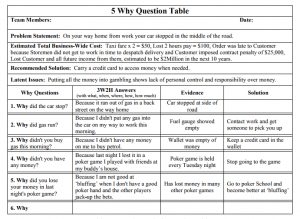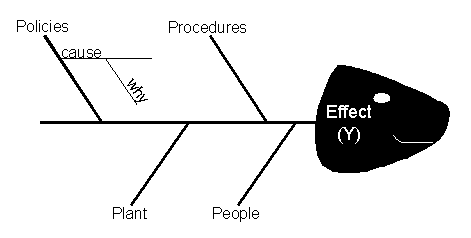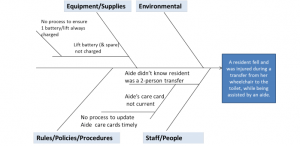Studying and Dissecting a problem to identify the root cause is called Fact Based Analysis. It also evaluates potential solutions to ensure it is being implemented in the most beneficial way. Below mentioned techniques can be applied during Sprint Retrospectives.
The problem-solving process in fact based analysis has six steps:
- Define the problem
- Analyze the problem
- Identify potential solutions
- Choose the best solution
- Plan action
- Implement solution and review progress
Fact based analysis Tools
- Five-why analysis is an informal and relatively simple tool for determining the root cause of a problem.
- Cause-and-effect diagram helps in determining all the potential causes of a problem.
- Force-field analysis is a tool you use to analyze the factors that help or impede a potential solution to a problem.
- Cost-benefit analysis is a tool for determining the financial payback of a potential solution or plan.
- Multi-attribute analysis is to compare various solutions to a problem, under a range of different attributes.
Steps for Fact based analysis
1. As a first step define the problem on the basis of facts and available details.
2. Analyze the problem can be subdivided into below mentioned 3 sub-steps.
- Identifying potential causes
- Determining the most likely cause
- identifying the root cause
There are two tools you can use to analyze the problem in fact based analysis – Five-why analysis & Cause-and-effect diagram
Five-Why Analysis
It has three simple steps
- State the problem
- Ask a question about the problem
- Continue to ask “Why?”
- Recognize the root cause
Benefits: Gets to the heart of the issue quickly so the underlying root cause can be found quickly.
Limitations: Focus on only one path, other paths are not explored fully.

Cause-and-Effect Diagram
Also known as a Fishbone Diagram, it identifies the main causes of a problem and the areas in which to search for solutions.
To construct a fishbone, start with stating the problem in the form of a question, such as “Why is the help desk’s abandon rate so high?” Framing it as a “why” question will help in brainstorming, as each root cause idea should answer the question. The team should agree on the statement of the problem and then place this question in a box at the “head” of the fishbone.
The rest of the fishbone then consists of one line drawn across the page, attached to the problem statement, and several lines, or “bones,” coming out vertically from the main line. These branches are labeled with different categories. The categories you use are up to you to decide. There are a few standard choices:
Service Industries
- Policies
- Procedures
- People
- Plant/Technology

Problem statement: A resident was anxious and needing to use the bathroom urgently. The aide was helping the resident transfer from her wheelchair to the toilet, without using a lift, and the resident fell, sustaining an injury. The aide stated she did not use the lift because the battery was being recharged, and there was no extra battery available. The aide stated she understood that the resident could be transferred with the assist of one.

Benefits: Structured showing all possible root causes. Adaptable showing overall picture of the problem.
Limitations: It is simple but information can be labeled incorrectly. Limited categories.
3. Identify potential solutions can be generated in several different ways
- Brainstorming
- Additional research
- Looking outside our own experience
- Consulting the decision maker
4. Choosing the best potential solution can be achieved through
- Cost-benefit analysis
- Multi-attribute analysis, and
- Force-field analysis
Cost-Benefit Analysis
The eight steps of cost-benefit analysis are as follows:
- Determine a time scale for your analysis
- Brainstorm a list of costs associated with your potential solution
- Determine a cost for each factor
- Brainstorm a list of benefits that your potential solution will effect
- Determine the benefits in monetary or tangible terms
- Sum the total costs and benefits
- Determine the cost-benefit ratio, and
- Decide which potential solution gives the best return
Benefits: Easy to determine if a solution is financially sound. Easy to decide whether one option is better than the other.
Limitations: Not suitable for large, diversified projects where there are intangible costs or benefits.
Multi-Attribute Analysis
To evaluate multiple solutions against weighted criteria. Each criteria is assigned a value relative to others. There are four steps
- Framing of the decision and identification of the goals and objectives to be achieved by the decision maker
- Identification of all decision alternatives and any related attributes that address the decision-making objectives
- Specification of preferences, both for each of the individual attributes and between the attributes in the framework
- Ranking of the decision alternatives according to the specified preferences, given the attribute data for each of the alternatives
Benefits: attribute analysis: Many factors measured at a time using matrix. Multiple criteria allow comparing solution side by side.
Limitations: As there are many factors sometimes all can’t be quantified and works on assumptions about factors and criteria.
Force-Field Analysis
Use a blank sheet of paper or a whiteboard, or download our worksheet and follow these five steps
- Describe Your Plan or Proposal for Change – Define your goal or vision for change, and write it down in a box in the middle of the page.
- Identify Forces For Change – Think about the kinds of forces that are driving change. These can be internal and external.
- Identify Forces Against Change – Brainstorm the forces (internal & external) that resist or are unfavorable to change.
- Assign Scores – Score each force, from, say, one (weak) to five (strong), according to the degree of influence each one has on the plan, and then add up the scores for each side (for and against).
- Analyze and Apply – To decide whether or not to move forward with the decision or change. To think about which supportive forces you can strengthen and which opposing or resisting forces you can weaken, and how to make the change more successful.
Benefits: Captures both positive and negative factors so that comparison can be drawn.
Limitations: Not suitable for a complex solution.
5. Plan action, Implement solution and review progress are the last steps in this fact-based analysis.
